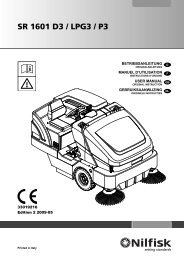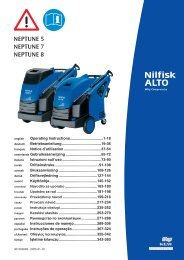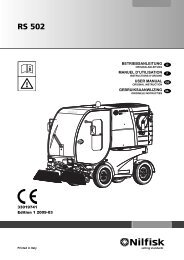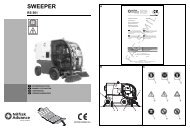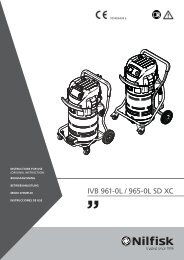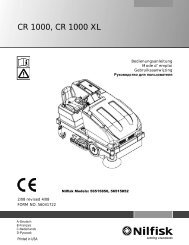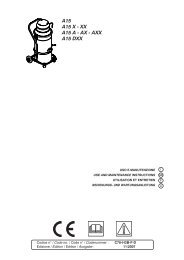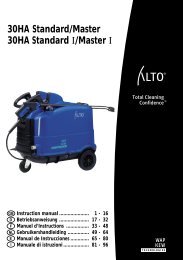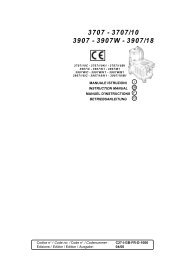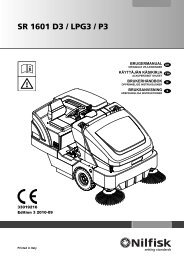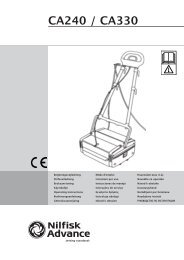Create successful ePaper yourself
Turn your PDF publications into a flip-book with our unique Google optimized e-Paper software.
Maintenance, cleaning and decontamination<br />
ATTENTION DANGER!<br />
NOTE: The precautions described below must be taken<br />
during all the maintenance operations, including cleaning<br />
and replacing the main and Hepa fi lters.<br />
A. To allow the user to carry out the maintenance<br />
operations, the vacuum must be disassembled,<br />
cleaned and overhauled as far as is reasonably<br />
possible, without causing hazards for the maintenance<br />
staff or other people. The suitable precautions include<br />
decontamination before disassembling the vacuum,<br />
adequate fi ltered ventilation for the air exhausted from<br />
the room in which it is disassembled, cleaning of the<br />
maintenance area and suitable personal protection.<br />
B. The external parts of class H and class M appliances<br />
must be decontaminated by cleaning and vacuuming<br />
methods, dedusted or treated with sealant before<br />
being taken out of a hazardous zone.<br />
All parts of the appliance must be considered as<br />
contaminated when they are removed from the<br />
hazardous zone and appropriate actions must be<br />
taken to prevent dust from dispersing.<br />
When servicing work or repairs are carried out, all the<br />
contaminated elements that cannot be cleaned well<br />
must be eliminated.<br />
These elements must be disposed of in sealed bags<br />
conforming to the applicable regulations and in<br />
accordance with the local laws governing the disposal<br />
of such material.<br />
This procedure must also be followed when the fi lters<br />
are eliminated (main, Hepa and downstream fi lters).<br />
NOTE: Compartments that are not dust-tight must be<br />
opened with suitable tools (screwdrivers, wrenches, etc.)<br />
and thoroughly cleaned.<br />
C. Carry out a technical inspection at least once a year,<br />
e.g.: check the air fi lters to fi nd out whether the airtightness<br />
of the appliance has been impaired in any<br />
way and make sure that the electric control panel<br />
operates correctly. This inspection must be carried out<br />
by the manufacturer or by a competent person.<br />
ATTENTION DANGER!<br />
Only use genuine spare parts.<br />
— 9 —<br />
3156 - 3156 L, M, H<br />
<strong>3306</strong> - <strong>3306</strong> L, M, H<br />
How to disassemble and replace the main and<br />
Hepa fi lters<br />
ATTENTION DANGER!<br />
When the vacuum cleaner is used to clean up hazardous<br />
substances, the fi lters become contaminated, thus:<br />
– work with care and avoid spilling the vacuumed dust<br />
and/or material;<br />
– place the disassembled and/or replaced fi lter in a<br />
sealed plastic bag;<br />
– close the bag hermetically;<br />
– dispose of the fi lter in accordance with the current<br />
laws.<br />
ATTENTION DANGER!<br />
Filter replacement is a serious matter.<br />
The fi lter must be replaced with one of identical<br />
characteristics, fi lter surface and category.<br />
Failing this, the vacuum cleaner will not operate correctly.<br />
Main fi lter replacement<br />
ATTENTION DANGER!<br />
Check the Class of the vacuum cleaner (L - M - H).<br />
Take care not to raise dust when this operation is carried<br />
out. Wear a P3 mask and other protective clothing plus<br />
protective gloves (DPI) suited to the hazardous nature of<br />
the dust collected.<br />
Refer to the relative laws in force.<br />
Before proceeding with this operation, turn off the machine and<br />
remove the plug from the power socket.<br />
Disassembly<br />
–<br />
–<br />
–<br />
–<br />
–<br />
–<br />
Remove the hose “A” (Fig. 12) from the lower outlet.<br />
Release stop “B” (Fig. 12) and unscrew fi lter shaker knob<br />
“C”.<br />
Release the two fastening latches “D” (Fig. 12) and<br />
remove lid “E”.<br />
Lift fi lter “F” (Fig. 12), unscrew clamp “G” and remove ring<br />
“H”.<br />
Unscrew cage “I” (Fig. 12) and turn the fi lter upside down.<br />
Cut the plastic clamps “L” (Fig. 12) and detach the cage<br />
from the fi lter.<br />
Assembly<br />
– Fit the fi lter catch and retention ring of the old fi lter on to<br />
the new one.<br />
– Insert cage “I” (Fig. 12) and fi x it to the fi lter by means of<br />
plastic clamps “L” on the bottom of the fi lter itself.<br />
– Fit the fi lter into fi ltering chamber then mount lid “E” (Fig.<br />
12) and lock it in place with the two fastening latches “D”.<br />
– Fit the fi lter shaker knob and lock it in the lowered position<br />
by means of the stop so that the fi lter is kept stretched.<br />
– Fit the suction hose on the lower outlet.<br />
–<br />
Dispose of the fi lter in accordance with the laws in force.<br />
GB



